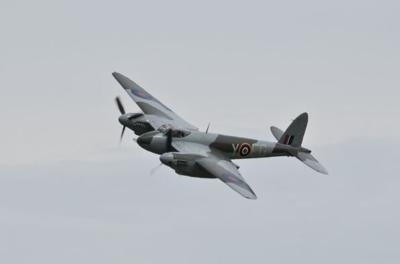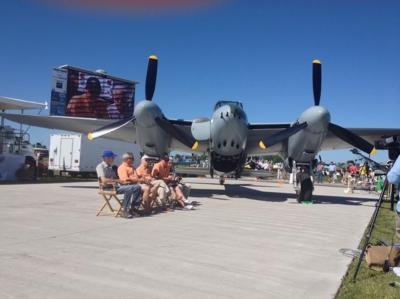WWII ‘The Wooden Wonder’ Flies Again After 60 Years
By Grace Huseth
EAA AirVenture 2015 is proud to present the legendary Royal Air Force fighter and bomber, the de Havilland Mosquito. In its first Oshkosh appearance, the only airworthy Mosquito to date will perform in various warbird shows throughout the week of the airshow.

The Mosquito arrived on AirVenture’s opening day to honor the Battle of Britain’s 75th anniversary. During WWII the Mosquito was fast and had light fighter-like handling. Named after the notoriously irritating and quick insect, it mastered small harassment raids. Its unique wooden frame was a thrifty choice to save metal for other purposes, while staying light and swift.
After seeing the success of the air force in the Battle of Britain, the Royal Air Force sped up plans in November 1940 for the prototype and order of the Mosquito to further improve the fleet, save costs with the wooden frame while doing so. The Mosquito’s glory days in 1943 were while performing low-altitude daylight bombing operations.
Today it has been restored back to its former glory thanks to Jerry Yagen, founder of four vocational aviation trade schools and avid warbird enthusiast. He has applied his investments to a wide collection of vintage aircraft which has evolved and grown into the Military Aviation Museum in Virginia Beach. Unlike other aviation museums, nearly every aircraft is in flying condition.
However, when he wanted to add the de Havilland Mosquito British hero to round out his collection, he realized it was his responsibility to place the British hero back in the air. He teamed with AVspecs, a company in New Zealand that specializes in warbird and vintage aircraft restoration.
Avspecs has been restoring old warbirds and vintage aircraft since 1986. They are located at Ardmore Airfield, home to New Zealand’s busiest airfield and the New Zealand Warbirds Association. They also have close proximity to heat treatment, NDT, Electoplating and foundry services that have been proven useful to over a dozen intensive restoration projects.
During a special reveal at Warbird Alley on Tuesday of the airshow, Jerry Yagen, owner of the Mosquito, Warren Denholm, Managing Director of AVspecs, Mike Spaulding, Chief Pilot in Virginia Beach, and Dave Philips, test pilot for the Mosquito in New Zealand gave an overview of the restoration process.
The de Havilland Mosquito required more of an overhaul than a traditional warbird. Before restoration, it was grounded in the Canadian elements for thirty years, housed by the Canadian Museum of Flight and Transport, and then reached New Zealand for renewal.

“A pile of wooden mush, that’s all it was,” Yagen said. Three years were dedicated to making the wooden airframe. AVspecs and Glyn Powell of Auckland, New Zealand restored the wooden fuselage, wings and tail sections with aircraft quality plywood. The twin-engine aircraft has extra buzz by two original Rolls Royce Merlin engines, four replica machine guns and 20mm cannons under the nose. Thanks to AVspecs creating a mold for the fuselage, there is a chance for more Mosquitos to be restored in the future.
“When you are starting on an aircraft people gave up on, you have to find all the drawings and technical information. You have to become those people yourself,” Denholm said.
Test pilot Philips said the first flight was surprisingly light and responded well despite the manual aileron. “For its era, it’s easy to manage,” he said. In 2012 it received the Certificate of Airworthiness by the Zealand Civil Aviation Authority (CAA) and returned to Virginia Beach.
In total, the warbird has an international influence to be celebrated. While its extensive family was flown with the British Royal Air Force, this particular Mosquito, model KA114, was manufactured in Canada and restored in New Zealand. The final paint job boasts the markings of Royal New Zealand’s 487 Squadron RNZAF to reflect the history of their unit’s WWII flying Mosquitos.
First-time attendee Mike Allsop was blown away when he saw the Mosquito at Warbird Alley.
“It was a complete surprise to see the Mosquito in Oshkosh. I thought, ‘bloody hell, how could I miss this!’,” he said.
Allsop is from Sydney, Australia where he has been a private pilot for 45 years. More ironically, his father flew the Mosquito in WWII as a pathfinder navigator for the Royal Australia Airmen assigned to the Royal Air Force.
Mike Allsop and his father Jim Allsop watched the online streaming of the first flight in New Zealand. One year later Jim passed away at age 90. Today Mike gives talks to rotary and business clubs about his father’s tale and is an advocate for recording WWII warbird stories before the veterans pass away.
Attendees at this year’s AirVenture will get a special performance by this unique aircraft throughout the week. The Mosquito will fly in various warbird shows and will be featured in a Warbirds in Review program on the flight line. Audiences will also be able to see the aircraft perform daily engine runs, with those making donations to the Mosquito’s flight thanked with a chance to sit in the cockpit during the runs.
Fans are trying to raise interest in flying the Mosquito to England for more nostalgic showings, but Mossie will return to the Military Aviation Museum. He will be flown again in the shows hosted by the museum and will be featured in the spring show dedicated to WWII aircraft.
(Staff image)
 ANN's Daily Aero-Term (04.24.24): Runway Lead-in Light System
ANN's Daily Aero-Term (04.24.24): Runway Lead-in Light System ANN's Daily Aero-Linx (04.24.24)
ANN's Daily Aero-Linx (04.24.24) Aero-FAQ: Dave Juwel's Aviation Marketing Stories -- ITBOA BNITBOB
Aero-FAQ: Dave Juwel's Aviation Marketing Stories -- ITBOA BNITBOB Classic Aero-TV: Best Seat in The House -- 'Inside' The AeroShell Aerobatic Team
Classic Aero-TV: Best Seat in The House -- 'Inside' The AeroShell Aerobatic Team Airborne Affordable Flyers 04.18.24: CarbonCub UL, Fisher, Affordable Flyer Expo
Airborne Affordable Flyers 04.18.24: CarbonCub UL, Fisher, Affordable Flyer Expo




